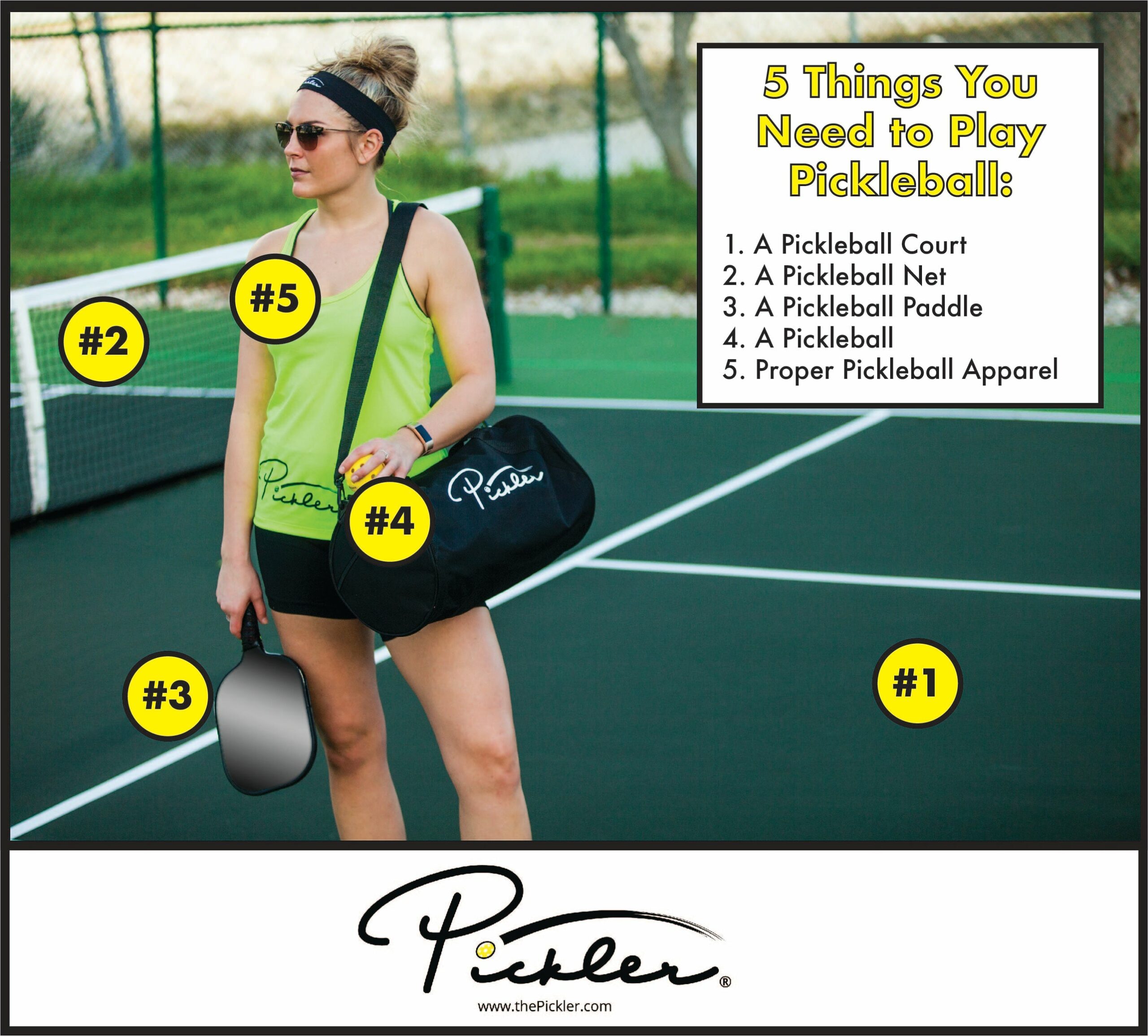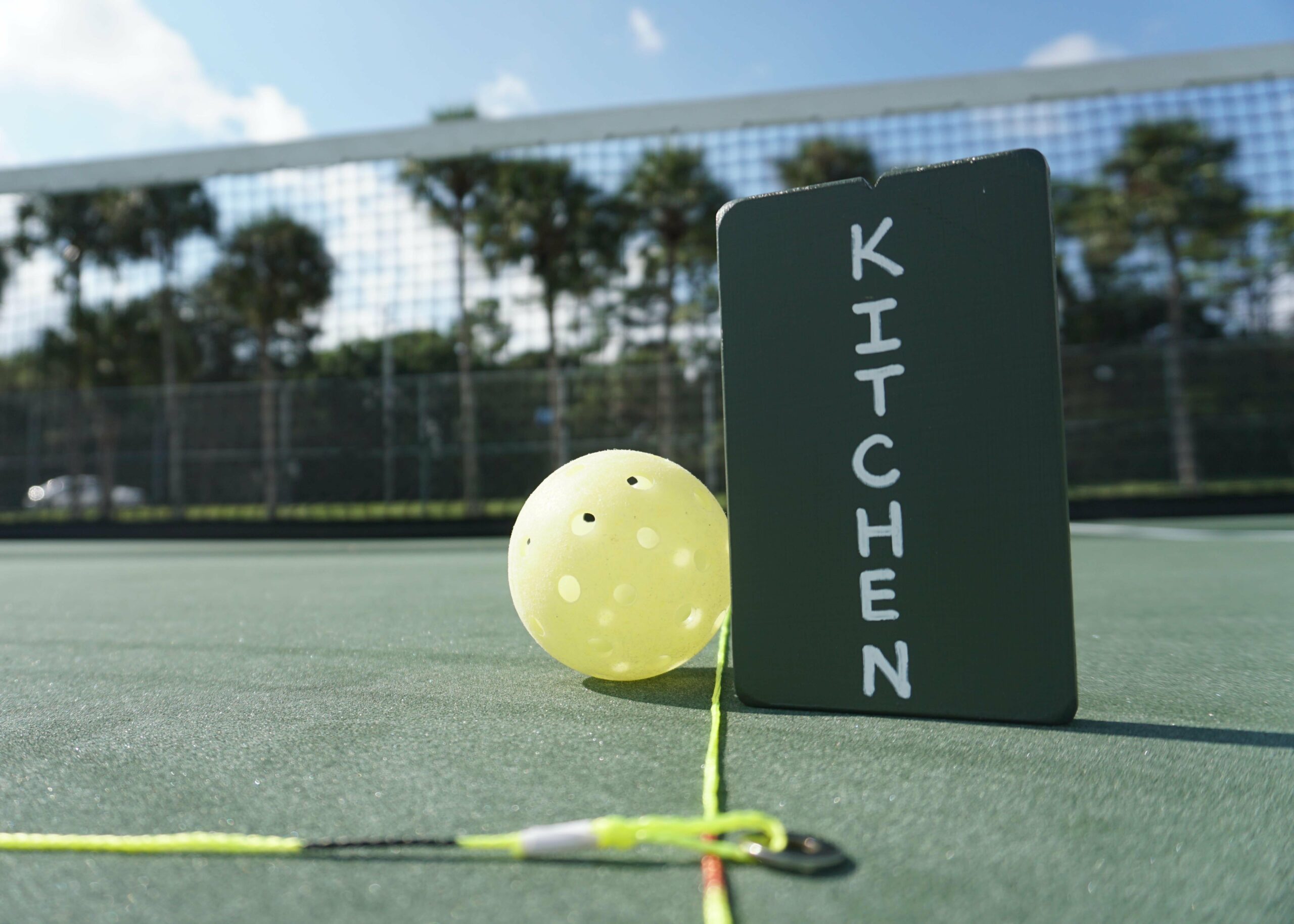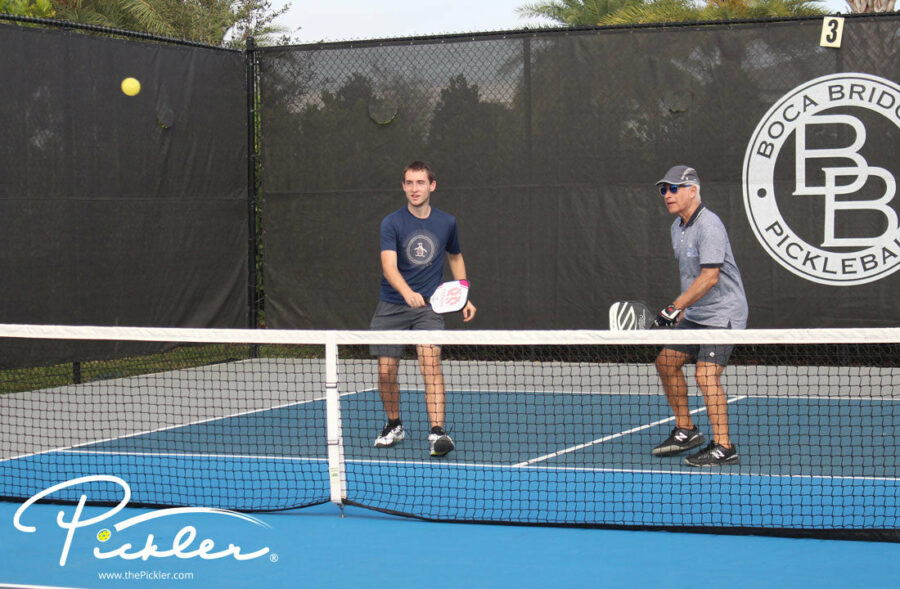One of the most fun games to play is pickleball. Other than a few friends, what do you need to play pickleball? There are 5 things that you will need before you join the fun:
- A court;
- A net;
- A pickleball paddle;
- A pickleball; and
- Proper pickleball apparel.
Let’s breakdown the rules and specifications on each one of these pickleball essentials.
Pickleball Court – The Space to Play Pickleball
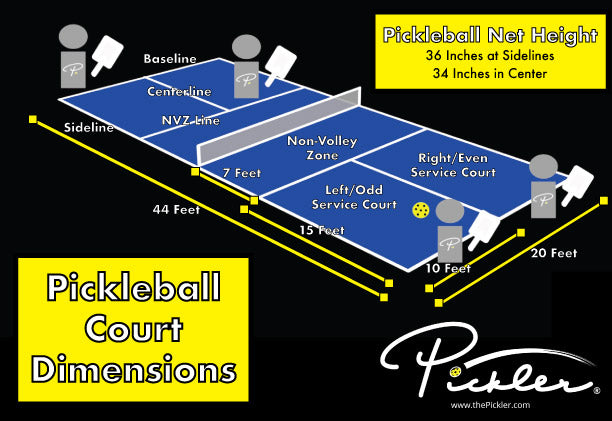
How Big Is a Pickleball Court? What Are the Dimensions of a Pickleball Court?
A pickleball court is 44 feet long by 20 feet wide (which is 880 square feet), which is the same size for both singles pickleball and doubles pickleball. Court measurements are to the outside of each line on the court, and each pickleball court line should be 2 inches wide.
Although pickleball court dimensions are 44 feet long by 20 feet wide, the recommended total playing area should be a bit larger, so there is room to run around the outskirts of the pickleball court without risk of injury. The recommended total playing area for a pickleball court is 60 feet long by 30 feet wide (which is 1,800 square feet), and best practices would be to increase to the total playing area to 64 feet long by 40 feet wide (which is 2,560 square feet), so that there is a 10-foot buffer around the entire pickleball court.
Pickleball Court Versus Tennis Court
To compare a pickleball court versus a tennis court, a tennis court is 78 feet long by 27 feet wide for singles (which is 2,106 square feet for singles) or 36 feet wide for doubles (which is 2,808 square feet for doubles). This means that you can fit up to 4 pickleball courts on 1 tennis court!
What Are the Lines on the Pickleball Court?
A pickleball court has four types of lines:
- Baselines;
- Sidelines;
- Non-Volley Zone lines (also known as Kitchen lines); and
- Centerlines.
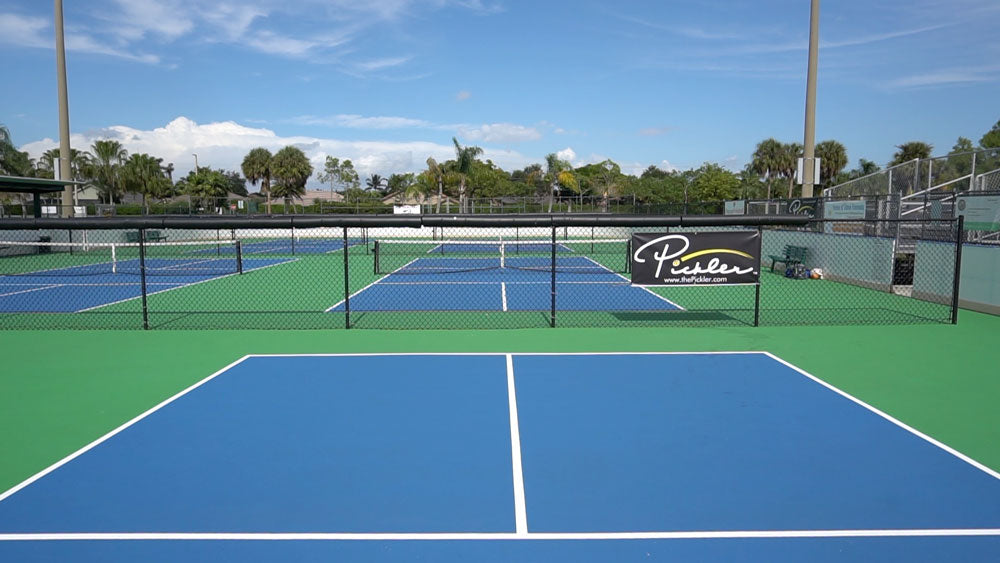
There are two baselines on a pickleball court. The baselines run parallel to the pickleball net, which cuts the pickleball court in half longways, and are on each end of the pickleball court. There are also two sidelines on the pickleball court. The sidelines run perpendicular to the pickleball net and are on each side of the pickleball court.
The Non-Volley Zone lines are the two lines that run parallel to the pickleball net that are 7 feet apart from the pickleball net. These Non-Volley Zone lines, as well as the two sidelines, mark out what is called the Non-Volley Zone in the sport of the pickleball, which is the 14-foot long by 20-foot wide space on either side of the pickleball net.
The remaining 15 feet on each side of the pickleball court, from the Non-Volley Zone line to the baseline, makes up the service areas on the pickleball court. The service areas are divided by a centerline. There are 4 service areas on a pickleball court, which are each called a “service court.” Each service court is the area between the applicable sideline, baseline, centerline, and Non-Volley Zone line, and is 10 feet wide (from the centerline to the sideline) and 15 feet long (from the baseline to the Non-Volley Zone line).
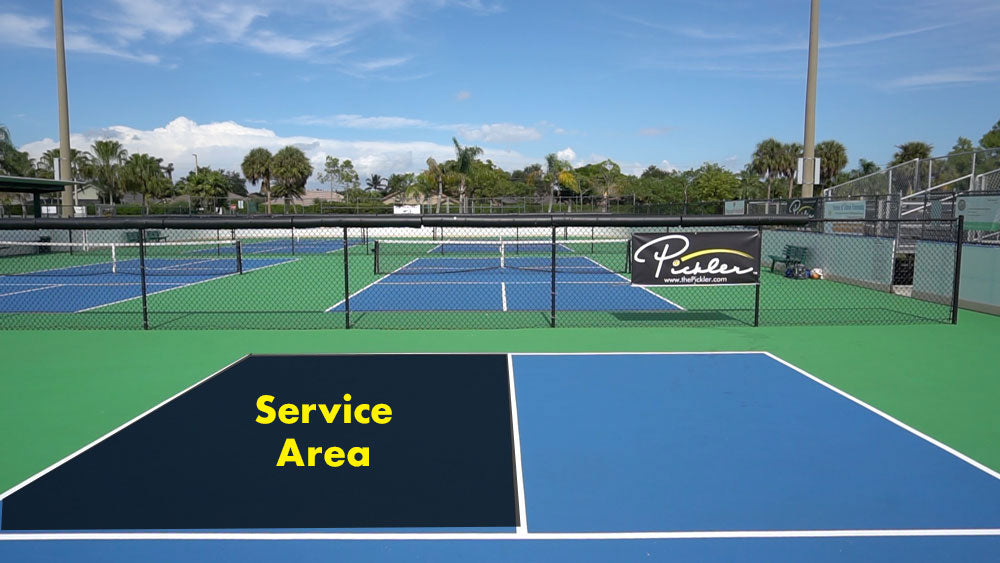
Pickleball Court Near Me
There are close to 8,000 places to play pickleball, with more than 30,000 pickleball courts, across the globe. Common places to play pickleball include senior-living communities, YMCAs, and local parks, schools, and recreation centers. To find a place to play pickleball near you, there are two great resources, which are USA Pickleball’s Places 2 Play and the Pickle Play app.
With that said, you can play pickleball on just about any hard surface that is at least 20 feet wide by 44 feet long. The fact that you have the ability to play pickleball just about anywhere is one factor that makes the sport of pickleball so great. Pickleball is accessible and relatively inexpensive to play. To learn how to create your own pickleball court, keep reading!
How to Create a Pickleball Court
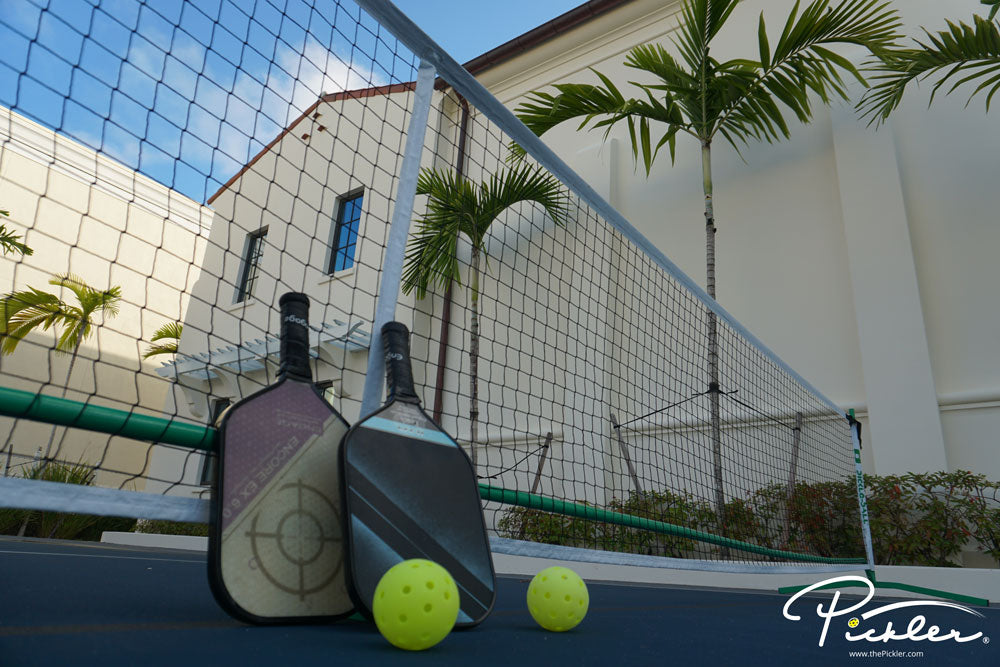
You can create a pickleball court on just about any hard surface that is at least 20 feet wide by 44 feet long. For instance, you can create a pickleball court on a tennis court, basketball court, or any other concrete, wood or gym floor, or hard surface by marking out pickleball court lines in accordance with the pickleball court dimensions described above. You could even create a pickleball court in your backyard or front driveway. Although not quite as popular, some players even play pickleball on alternative surfaces, including clay tennis courts.
To create lines for a pickleball court in any of these places, try using pickleball line kits (such as Pickleball On the Go), tape, or even chalk, which are all temporary lining options. Paint would clearly work to create pickleball lines, but paint would be more permanent. Any markings that clearly create the lines of a pickleball court will work.
You will need a pickleball net to complete your homemade or DIY pickleball court. If you create a pickleball court on a tennis court, then you could use the tennis net as a pickleball net (although the tennis net may be a bit higher than a pickleball net). Otherwise, to complete your pickleball court, you will need a temporary net, which is a pickleball net that you can set up or take down at any time (in other words, a net that is not permanent).
If you are looking to create or construct a permanent pickleball court, USA Pickleball and the American Sports Builders Association (ASBA) have produced a pickleball court construction and maintenance of manual, which is available for purchase.
Pickleball Net – The Dividing Factor on the Pickleball Court
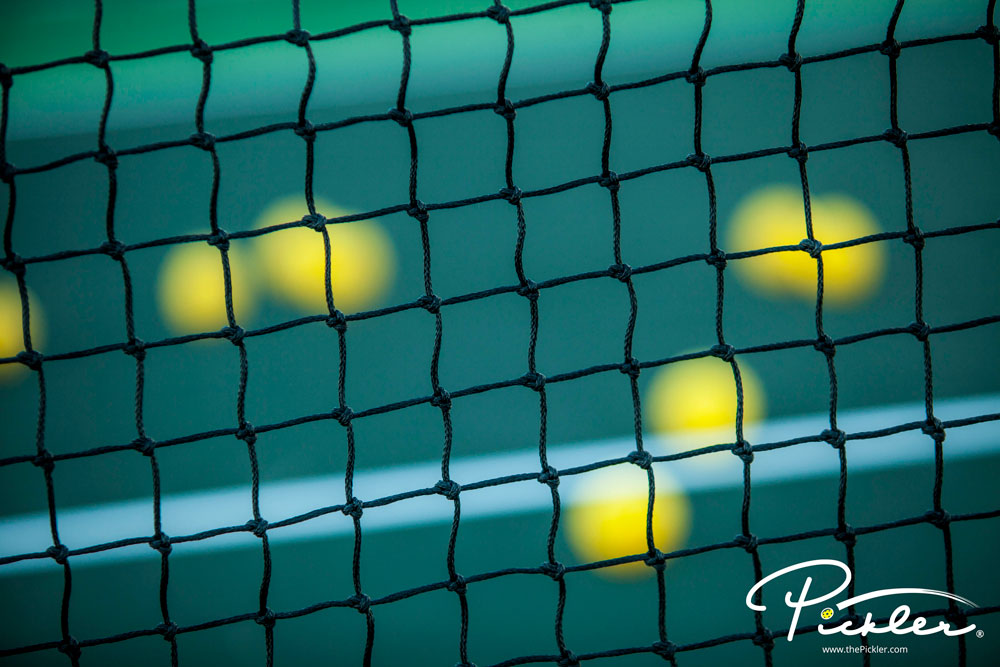
Pickleball Net & Pickleball Net Height
A pickleball net is one of the few essential items required to play pickleball. A pickleball net is a mesh fabric material that cuts the pickleball court in half and will not allow a pickleball to pass through it. The net should hang over the center of the pickleball court, so that the pickleball net height is 36 inches high on the sidelines and 34 inches high in the center of the pickleball court.
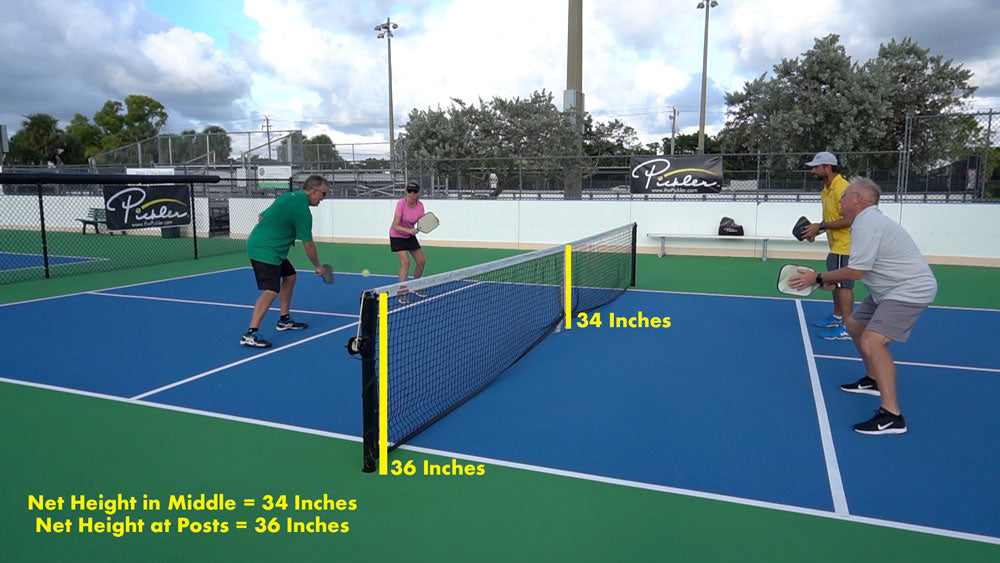
Pickleball Net Versus Tennis Net
To compare a pickleball net versus a tennis net, a pickleball net is lower. A tennis net is 42 inches high at the net posts, and 36 inches in the center of the court. So, a pickleball net is 6 inches lower at the sidelines than a tennis net, and a pickleball net is 2 inches lower than a tennis net in the center of the court.
Specific Pickleball Net Dimensions & Size
To be more specific, the pickleball net dimensions should be at least 21 feet, 9 inches long by at least 30 inches high/wide. The material should not be too high/wide though, as the net should not drape or otherwise lie on the pickleball court. This is because too much material sitting on the court could interfere with and alter the bounce of the pickleball. If a net has extra mesh fabric material at the bottom, then ties could be used to prevent the net from draping or otherwise lying on the pickleball court.
The pickleball net should hang from the two net posts on the pickleball court. The net posts should be 22 feet apart (measuring from the inside of one net post to the inside of the other net post).
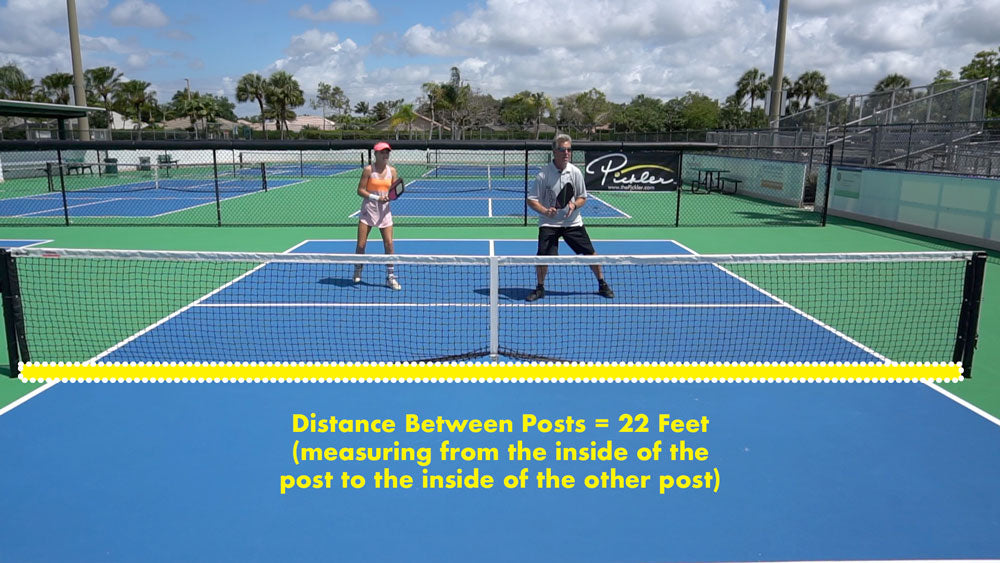
The net should also have an edge at the top of the net that consists of two inches of white tape. This edge should cover the cord or cable that connects the net to the two net posts. A center strap is also recommended on a pickleball net, as the center strap will help for easy adjustment of the net to the proper height of 34 inches in the center of the pickleball court.
Pickleball (or Pickleball Ball) – The Center of It All
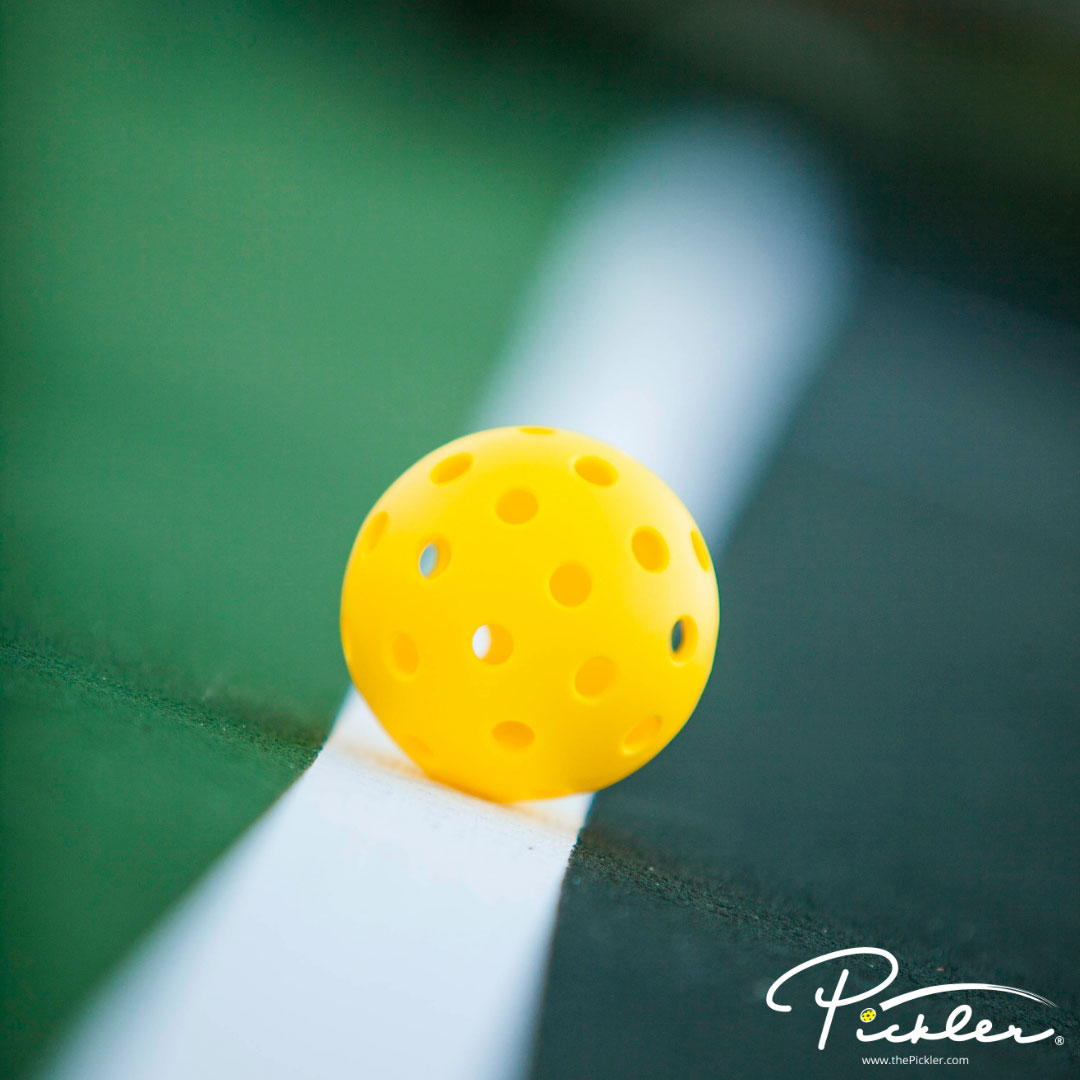
Three common questions when it comes to a pickleball (or a pickleball ball) are:
- What is a pickleball made out of?
- How many holes does a pickleball have?
- How big is a pickleball?
A pickleball is a ball made out of smooth, durable material and looks like a wiffle ball. A pickleball must have between 26 and 40 circular holes. These pickleball holes must be spaced, and otherwise designed, to conform to flight characteristics. A pickleball must be one uniform color – although the colors may vary based on the pickleball brand – and will be between 2.87 inches to 2.97 inches in diameter and weigh between 0.78 and 0.935 ounces.
Some, but not all, pickleballs may also have a seam that seals two manufactured halves of a pickleball together. This seam on the pickleball is permitted, as long as the seam does not impact the pickleball’s flight characteristics.
Indoor Pickleball Versus Outdoor Pickleball
Did you know that there are both indoor pickleball balls and outdoor pickleball balls? Before jumping into the details, it is important to note the key difference between indoor and outdoor pickleball. Indoor pickleball generally refers to pickleball played on a gym floor or wood floor surface. On the other hand, outdoor pickleball generally means pickleball played on a hard-court surface. Nevertheless, there could be hard court surfaces for pickleball that are indoors – especially in cold-weather climates. So, indoor pickleball, in certain circumstances, could also include pickleball played on a hard-court surface.
One of the biggest differences between an indoor pickleball and an outdoor pickleball is the number and size of holes. To compare an indoor pickleball versus an outdoor pickleball, an indoor pickleball typically has less holes than an outdoor pickleball. However, the holes in an indoor pickleball are typically larger than an outdoor pickleball. The difference in holes between an indoor pickleball and an outdoor pickleball is largely due to the different elements of indoor play versus outdoor play – indoor play will have climate control and a wood or concrete playing surface, while outdoor play will have wind and a hard-court playing surface.
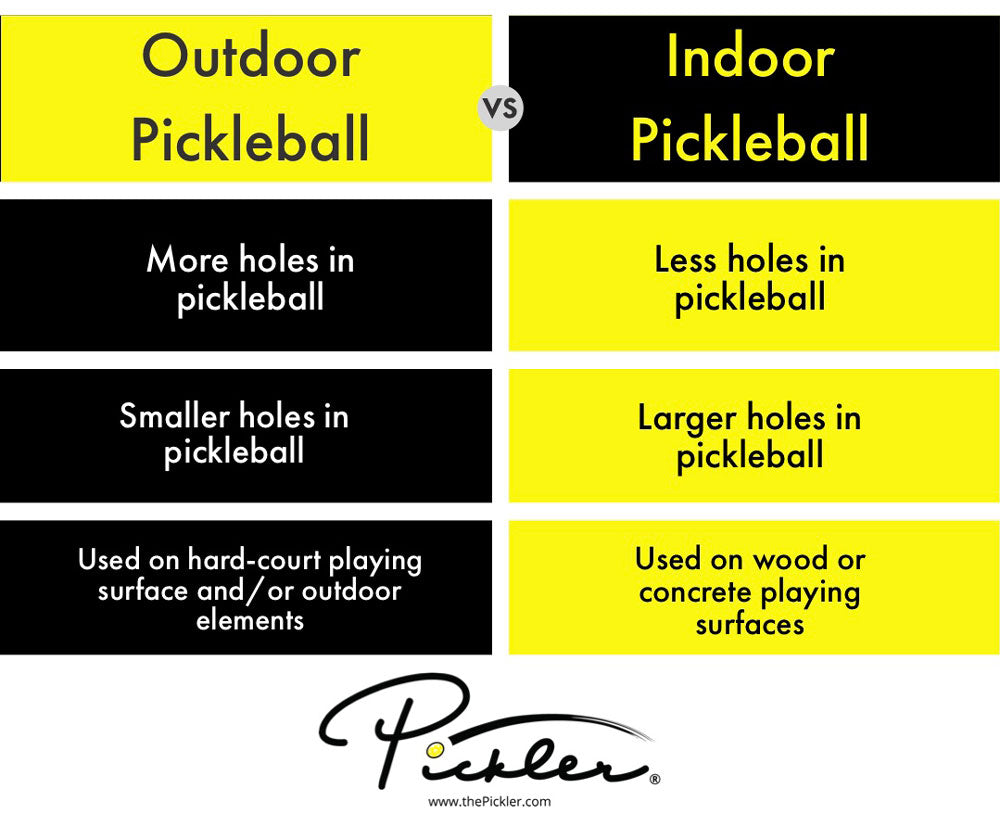
With that said, all pickleballs that are approved for play by USA Pickleball – whether indoor or outdoor – are acceptable for both indoor and outdoor play. Nevertheless, most players have a preferred pickleball for indoor play that is different than their respective preferred pickleball for outdoor play. Further, most professional pickleball players (also known as pickleball pros) play with the Dura Fast 40 outdoor pickleball or the Franklin X-40 pickleball. This is because most pickleball pros play outdoor pickleball (or pickleball on a hard-court surface), rather than indoor pickleball (or pickleball on a gym floor or wood floor surface).
How High Does a Pickleball Bounce?
A pickleball must have a bounce between 30 and 34 inches (measured from the ground to the top of the pickleball) after being dropped from a point that is 78 inches above the ground onto a granite surface plate. A pickleball must also have a hardness of 40 to 50 on a Durometer D scale. Temperature may have an effect on the bounce and hardness of the pickleball, so it is important to do these tests in an environment with a temperature of between 65- and 75-degrees Fahrenheit.
Pickleball Paddle – The Weapon of Choice on the Pickleball Court
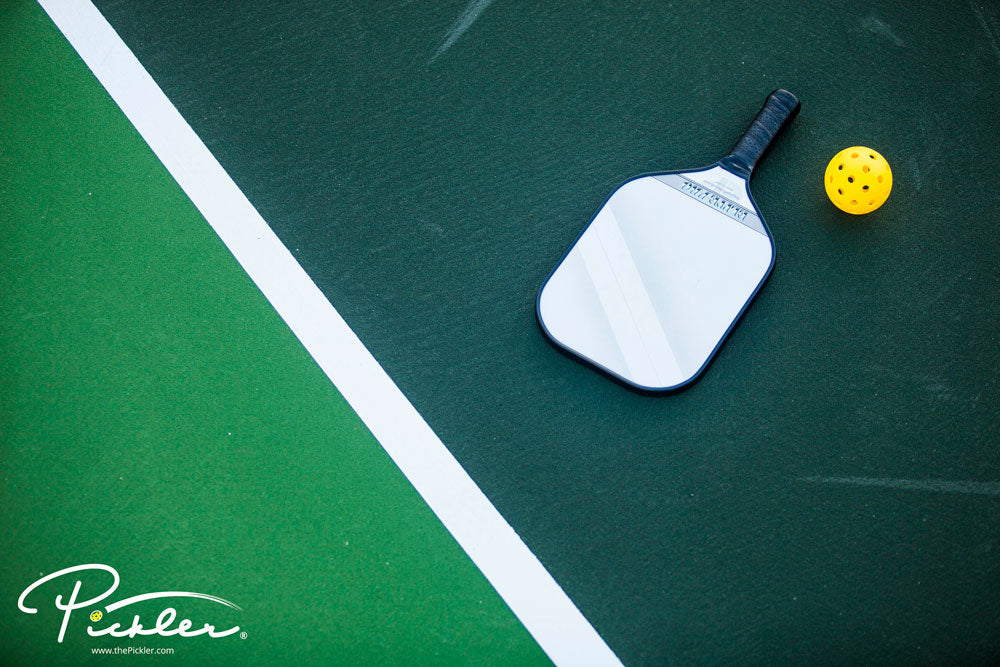
What Is a Pickleball Paddle Made Of?
A pickleball paddle must be made out of rigid, non-compressible material that is safe and complies with the Official Rules. This material could include, among others, wood or a composite material. However, a pickleball paddle may not have any moving parts (including any electronic, electrical, or mechanical parts), removable parts, springs or springy material, or compressible or flexible material. Even under these restrictions, a pickleball paddle is not indestructible, as pickleball paddles can wear out from use over time – especially as often as most pickleball players (who we like to call Picklers!) play the sport of pickleball!
Pickleball Paddle Size Rules
The pickleball paddle size – the length and the width – is also regulated. The combined length and width of the pickleball paddle (including the edge guard and cap on the handle) may not exceed 24 inches, while the length of a pickleball paddle may not exceed 17 inches. Neither the pickleball paddle thickness nor pickleball paddle weight is regulated. In other words, a pickleball paddle can be as thin or thick as desired, and as light or heavy as desired, as long as the pickleball paddle meets the other pickleball paddle rules. This includes paddle grip size – a pickleball paddle grip can be as thin or thick as desired.
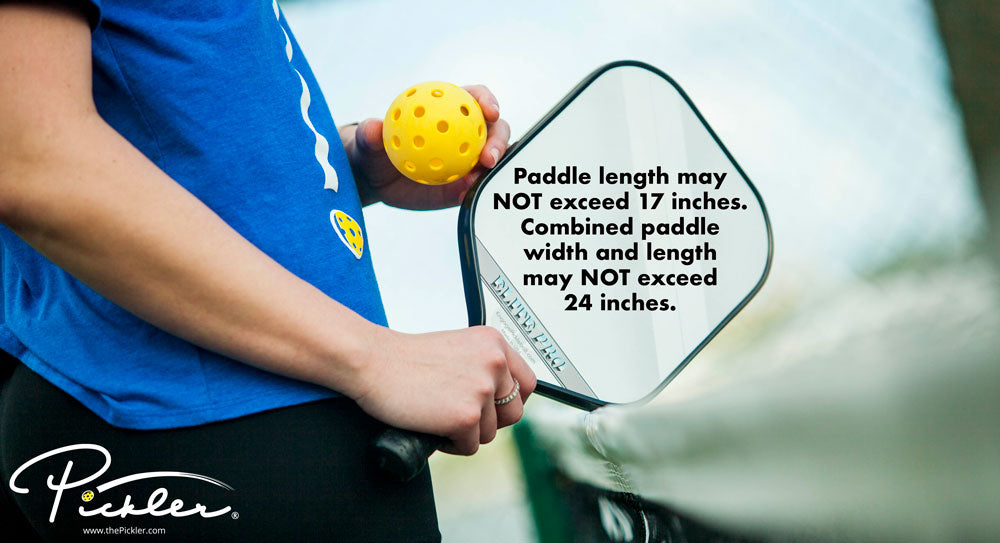
Pickleball Paddle Surface Rules
There are a lot of pickleball rules around the pickleball paddle surfaces.
- First and foremost, the pickleball paddle surface may not have any holes, indents, cracks, de-lamination or breaking of the paddle skin, or a rough or textured paddle surface.
- Further, a pickleball paddle may not have any sand- or rubber-textured paint or other rubber or sandpaper characteristics. Such marks, features, or characteristics would likely make the pickleball paddle illegal. This is because these marks, features, and characteristics may have the effect of creating additional spin on the pickleball.
- The roughness of a pickleball paddle is actually a key component of testing by USA Pickleball for approved paddles for play. This is because too much roughness will drastically affect the ability to put spin on the pickleball, which could alter the pace of pickleball play.
- For the engineers and scientists of the world, pickleball paddles are tested based on the Starrett SR160 Surface Roughness Tester to ensure that the roughness on the paddle surface is no more than 30 micrometers on the Rz reading and no greater than 40 micrometers on the Rt reading.
- Not only is the roughness of a pickleball paddle surface regulated, but so too is how the pickleball paddle surface looks. A pickleball paddle may not have a reflective surface, as it would adversely affect the opponent’s ability to see the pickleball. The reflectiveness of a paddle surface is also tested by USA Pickleball (the paddle surface cannot have more than 80 GU when measured at 60 degrees with ETB-0833 Self-Calibration 20-degree 60-degree 85-degree Surface Glossmeter Tester 0-200 GU).
- Lastly, the pickleball paddle may not have any writing, pictures, drawings or other marks on the surface that are in bad taste.
Pickleball Paddle Alterations
Did you know that there is a very limited list of ways that you can alter, or add to, your pickleball paddle? This limited list of ways includes:
- Adding edge guard tape (which is generally used to protect your edge guard from nicks and scrapes that inadvertently occur during play or transport);
- Adding lead tape (which will add weight to your paddle);
- Changing the grip size or adding a grip wrap; and
- Adding name decals or other identification markings on the paddle face.
All decals and tape must remain within 1 inch of the top of the grip and within 0.5 inches of the edges of the paddle (whether the outer edge or the edge guard). Handwritten markings (which are limited to pen markings, and no other “aftermarket” graphics) are allowed anywhere on the pickleball paddle, but such handwritten markings cannot impact the roughness of the pickleball paddle and must be in “good taste.”
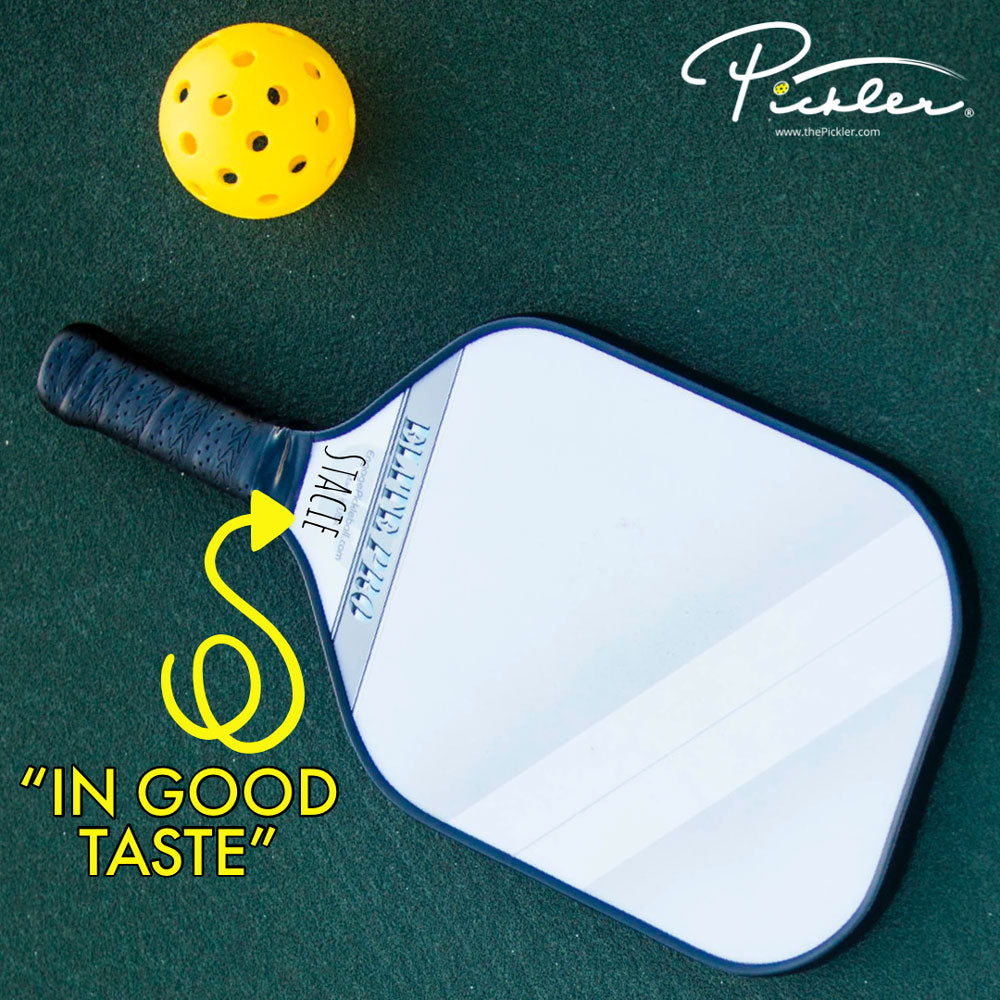
Homemade or DIY Pickleball Paddles Are Prohibited
Only commercially made pickleball paddles are permitted under the Official Rulebook. Further, all pickleball manufacturers must include their brand name and model name or number clearly marked on each paddle. As a result, pickleball paddles that are not commercially made (in other words, homemade or DIY pickleball paddles) are not allowed.
Illegal Pickleball Paddles
During a pickleball tournament, only pickleball paddles that (1) meet the standards and rules described above, and (2) are approved by USA Pickleball for pickleball play, are permitted to be used by players. Pro Tip: If you are playing in a pickleball tournament, be sure to confirm that your pickleball paddle is on the USA Pickleball Approved Paddle List. If not, you could be penalized!
If a player is found to be playing with an illegal pickleball paddle (in other words, a pickleball paddle that either violates the standards and rules for material, size, surface, alterations, or otherwise, or is not an approved pickleball paddle) in a pickleball tournament, then the player may be penalized. However, whether a penalty is imposed depends on when the illegal paddle is noticed.
- If the illegal pickleball paddle is noticed at the beginning of a match in a pickleball tournament, then the player may switch to another paddle, with no penalty.
- If the illegal pickleball paddle is noticed during a match, then that player or team forfeits that match. The player or team is permitted to play additional matches (assuming that the resulting forfeit did not put the violating player or team out of the tournament bracket).
- If the illegal pickleball paddle is noticed after the match, then the match results stand, with no penalty.
Proper Pickleball Apparel – What to Wear to Play Pickleball
The last thing you need to play pickleball is the right apparel, which includes a comfortable outfit for physical activity and the right shoes.
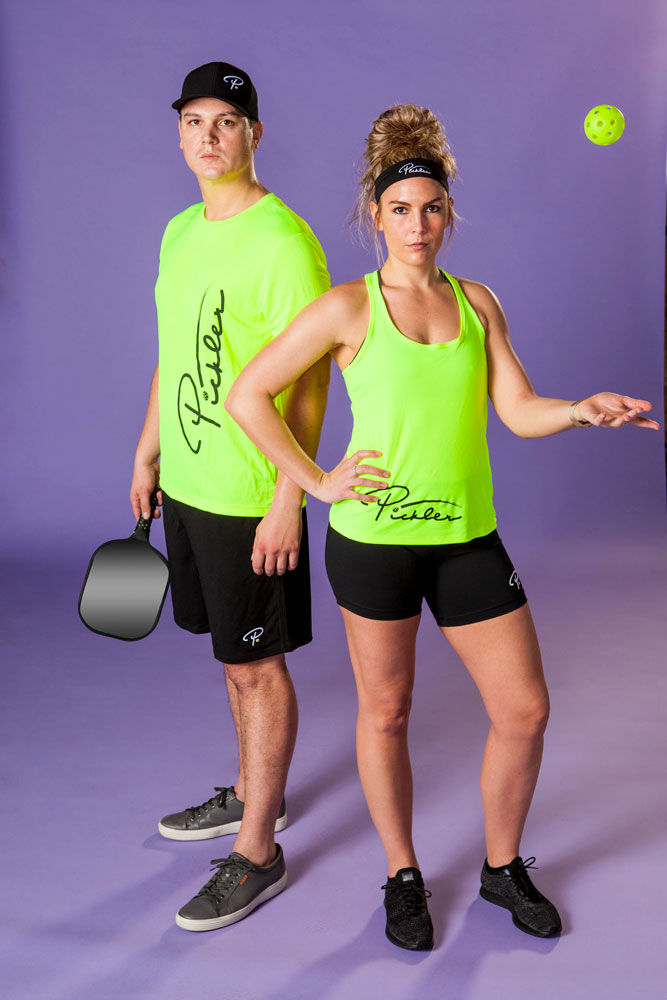
However, when selecting your outfit, beware that the Official Rulebook states that a player may be required to change outfits if the outfit is inappropriate. This could include an outfit that causes a safety risk or distraction on the pickleball court (e.g. camouflages the pickleball by being the same or substantially the same color as the pickleball) or an outfit that has pictures, writing, symbols, or other graphics that are not in good taste. Also, to note, shoes may not mark or damage the pickleball court’s playing surface.
It is important to comply with these pickleball apparel rules, especially during tournament play, as a player could end up forfeiting a match if a tournament director requests an outfit change and the playing refuses to change.
Summary – 5 Things You Need to Play Pickleball
Now that you have the 5 things you need to play pickleball – a court, a net, a pickleball paddle, a pickleball, and proper pickleball apparel, the last thing to do is round up some friends and join the fun! Whether old friends or new friends, you need at least one friend to play singles pickleball and three friends to play doubles pickleball. The easiest way to make new friends is to play pickleball, so get out there on the pickleball courts!
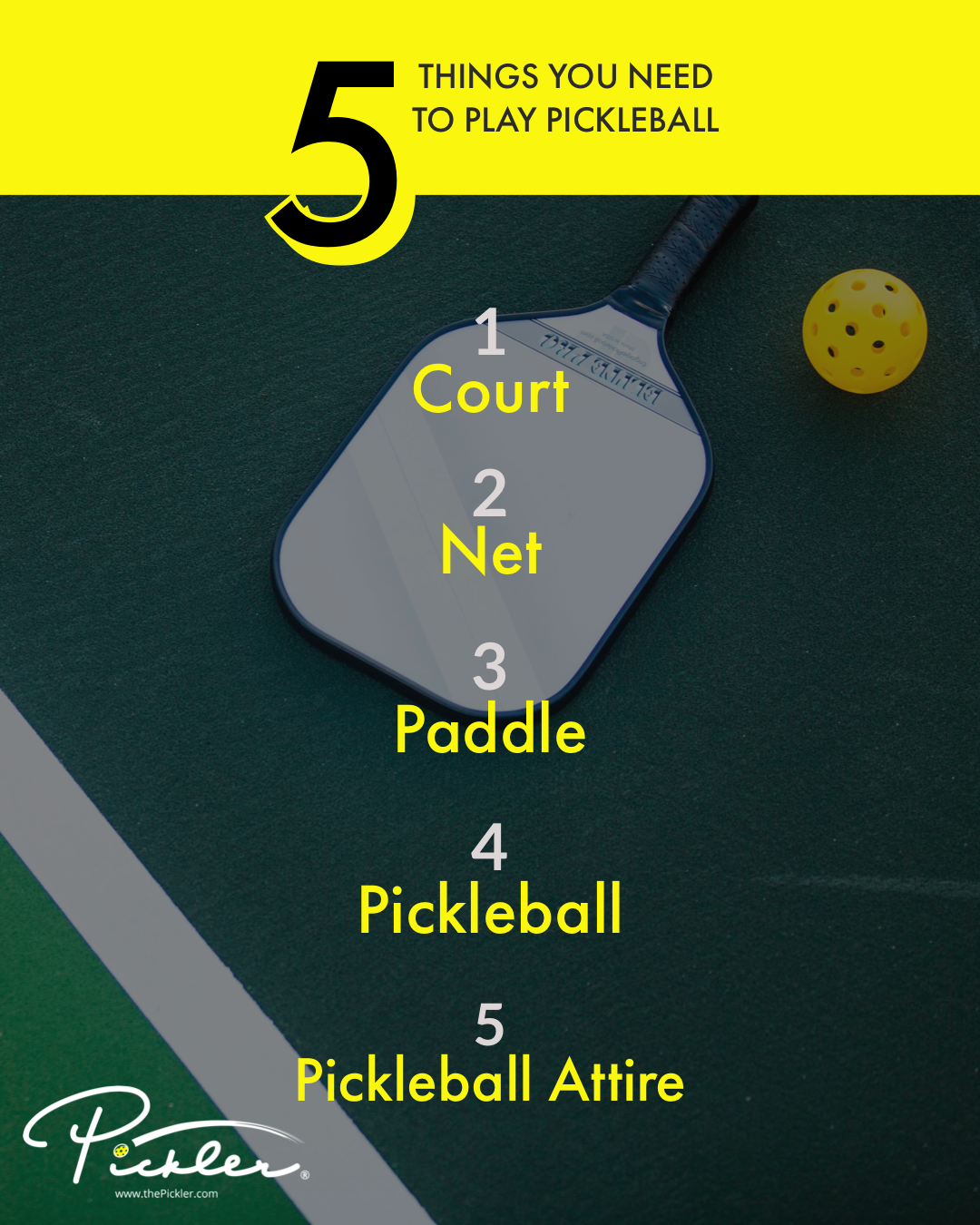
Looking for a new pickleball paddle? Grab Pickler’s discounts for some of the best pickleball paddles on the market!
Looking for More Pickleball Rules?
We know pickleball rules can be tricky at times. Don’t worry. Pickler explains the ins and outs of all of the pickleball rules in a series of pickleball rules blogs to make sure that you make the right call on the pickleball court. Learn more by visiting Pickler’s pickleball rules blogs that are linked below!
- Pickleball Rules – The Ultimate Guide to the Rules of Pickleball
- 10 Must Know Pickleball Rules Before Your Hit the Court
- 10 Pickleball Rules Changes to Learn for 2021
- Pickleball Rules – Learn How to Start – 5 Things You Need to Play
- Pickleball Dictionary – Quickly Learn the Pickleball Vocabulary
- Pickleball Serving Rules – Master the Start of Every Pickleball Game
- Pickleball Scoring Rules – Learn How to Keep the Score in Pickleball
- Pickleball Kitchen Rules – Learn Important Non-Volley Zone Rules
- Pickleball Line Call Rules – How to Make the Right Call
- Pickleball Rules – Faults & Dead Balls on the Pickleball Court
- Pickleball Rules – Commonly Misunderstood Rules in Pickleball
- Pickleball Tournament Rules – Must Read Before a Tournament
- Singles Pickleball Rules – How to Play Singles Pickleball
- Wheelchair Pickleball Rules – How to Play Wheelchair Pickleball

